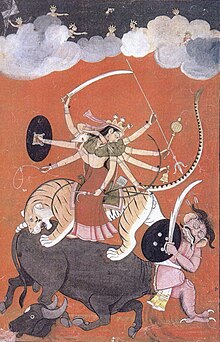Guler State
| Guler State गुलेर | |||||||||
|---|---|---|---|---|---|---|---|---|---|
| Princely State | |||||||||
| 1415–1813 | |||||||||
| Area | |||||||||
• | 65 km2 (25 sq mi) | ||||||||
| History | |||||||||
• Foundation of the state | 1415 | ||||||||
• Annexed by the British Raj | 1813 | ||||||||
| |||||||||
| Today part of | Himachal Pradesh, India | ||||||||

Guler was a small precolonial Indian hill state in the Lower Himalayas. Its capital was the town of Haripur Guler, in modern-day Himachal Pradesh. The kingdom was founded in 1415 by Raja Hari Chand, a scion of the ancient royal family of Kangra.[1]
Guler State is famous as the birthplace of Kangra painting in the first half of the 18th century when a family of Kashmiri painters trained in Mughal painting Style sought shelter at the court of Raja Dalip Singh (r. 1695–1741) of Guler. The rise of Guler Paintings or Guler style started in what is known as the early phase of Kangra art.[2]
History
Early history
According to legend Guler state was founded at an uncertain date between 1405 and 1450 by Raja Hari Chand, a Rajput of the Katoch dynasty from the Kangra Royal Family. One fateful day he fell into a dry well while hunting. Since no one could find him the Raja was presumed dead and his brother was then named Raja of Kangra State. When Raja Hari Chand was eventually brought back alive from the well, instead of fighting for his rights to the throne, he founded the town of Haripur on the flat below the fort by the Banganga River.[3]
British Raj
In 1813 Guler State was annexed to British India, after a brief period of Sikh rule under Maharaja Ranjit Singh. Bhup Singh (1765 - d. 1826) was the last ruling Raja. He accepted a jagir in Nandpur in 1826. The jagir was recognized by the British government in 1853. In 1877 his son Shamsher Singh died without male heirs and the state lapsed.
Rulers
The rulers of Guler State bore the title 'Raja'.[4]
Rajas
- 1540 – 1570 Ram Chand (Fifteenth ruler)
- 1570 – 1605 Jagdish Chand
- 1605 – 1610 Vijaya Chand
- 1610 – 1635 Rup Chand Bahadur
- 1635 – 1661 Man Singh
- 1661 – 1675 Vikram Singh
- 1695 – 1741 Dalip Singh (b. 1688 – d. 1741)
- 1695 – 1705 Bilas Devi (f) -Regent
- 1730 – 1741 Govardhan Singh -Regent (b. 1713 – d. 1773)
- 1741 – 1773 Govardhan Singh (s.a.)
- 1773 – 1790 Prakash Singh (b. 1748 – d. 1820)
- 1790 – 1813 Bhup Singh (b. 1765 – d. 1826)
Guler Paintings
Guler State was famous as the cradle of the Kangra paintings. Guler style painting constitutes the early phase of Kangra Kalam. About the middle of the eighteenth century some Hindu artists trained in Mughal style sought the patronage of the Rajas of Guler in the Kangra Valley. There they developed a style of painting which has a delicacy and a spirituality of feeling. The drawing in Guler painting is marked by liquid grace and precision. The colours which emphasize cool blues and greens are handled with skill. Guler artists had the colors of the dawn and the rainbow on their palette.
Of the hill states Guler has the longest tradition in the art of painting. During the rule of Raja Dalip Singh (1645–1743) artists were working at Haripur Guler. However it was during the reign of Govardhan Chand (1743–1773) that an active school of painting developed at Haripur Guler. There are numerous portraits of this Raja in the Chandigarh Museum.[5] Govardhan Chand's son Prakash Chand (1773–1779) continued the patronage of artists. His son Bhup Chand (1790–1826) also had artists working under him. Painting in Guler continued right up to the close of the 19th century.
The art of Guler style painting flourished in families with distinguishable styles and techniques, most significant amongst them were that of Pandit Seu of Guler, who died in about 1740, and his sons, the remarkable Nainsukh and Manaku. Later while Manaku worked at Guler, Nainsukh migrated to Jammu.[6]
See also
References
- ^ Guler (Princely State)
- ^ Hill Post - Guler Style
- ^ Mark Brentnall The Princely and Noble Families of the Former Indian Empire Himachal Pradesh, vol. I: Himachal Pradesh, Indus Publishing, 2004, ISBN 8173871639, ISBN 9788173871634, p. 304
- ^ Princely states of India
- ^ Chandigarh Museum - Kangra paintings
- ^ Hindu Hill Kingdoms Archived 30 March 2010 at the Wayback Machine V&A Museum
Further reading
- Kossak , Steven (1997). Indian court painting, 16th–19th century.. New York: The Metropolitan Museum of Art. ISBN 0870997831. (see index: p. 148-152, for more information about Guler Painting)
External links
 Media related to Guler style at Wikimedia Commons
Media related to Guler style at Wikimedia Commons- History of Guler State
